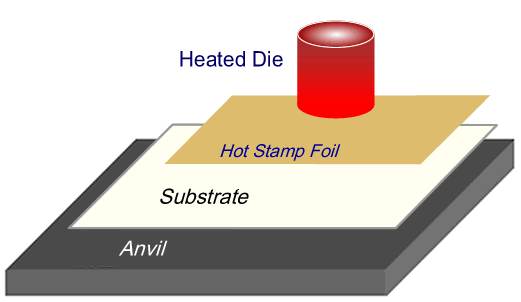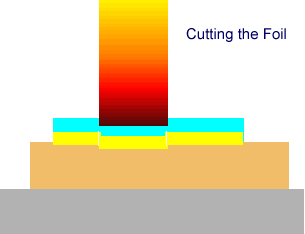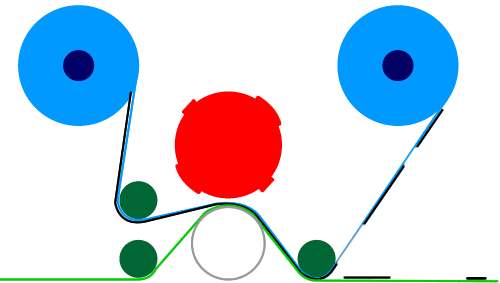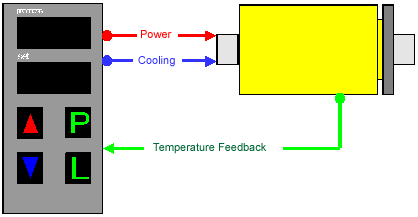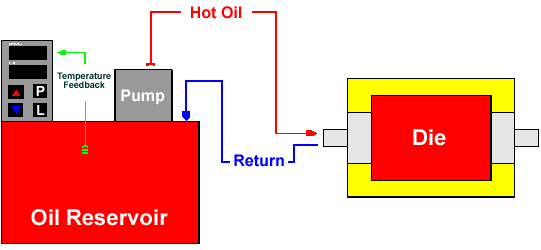| |

Site Map

DMS, Inc.
Rotary die maker.
Rotary dies for
economy, speed
and efficiency. Hot stamping equipment,
hot stamping dies.
Flexo press accessories.
|
|
Hot stamping is a process for transferring a dry film to a substrate through heat and pressure.
This requires the following basic components:
Main Components of the Hot Stamping Process:
|
|
ANVIL Usually made of a hard rubber or phenolic. The anvil must be hard enough to resist cupping under the load of the die, soft enough to protect the die from irregularities in the substrate, and resilient enough not to take a set through repeated pounding.
SUBSTRATE A wide variety of substrates are suitable for the hot stamping process. Surface tension of the substrate has the same affect on hot stamping as it does on printing. In addition to surface tension, the porosity of the material has a profound affect on stamping speed. A dry material will tend to cool the foil before it gets a chance to adhere properly. The resulting stamp will show a mottled surface similar to how ink looks on such a material. As a rule of thumb, a material that prints well will also stamp well.
|
ROLL LEAF Also known as Foil Roll leaf is the ink of a hot stamping operation. It is made up of a carrier with a series of coatings to be transferred. The carrier is made from polyester film that can range from just under 0.0005" to about 0.0015". The thinner the carrier, all other things being equal, the faster the foil will transfer.
The first layer applied to the carrier is a thin release coat. This layer affects whether or not a foil is suitable for fine copy or heavy coverage and affects the "cutting" properties of the foil.
The second layer called the "tie" or "color" coat serves dual purposes in a roll leaf product. |
|
The first function of this layer is to provide a hard abrasion resistant surface to the foil when applied. At 1.2-1.5 microns the tie coat makes up about 30% of the transferred product. Since the metallic layer is always made from aluminum, a tint is required to make a gold or other colored metallic . This tint is the second function of the tie coat.
Under the tie coat is a vacuum deposited aluminum layer. This is the most opaque layer in the construction even though it is only 0.02-0.05 microns thick. This layer has no structural integrity of its own.
The final layer in the foil construction is the sizing. This is a heat-activated adhesive that glues the foil image to the substrate. At 1.5-3 microns this layer makes up 50-70% of the transferred product. A thin layer of sizing cuts cleanest and tends to work best on films or high gloss materials. Heavily sized products do a better job of filling a more porous substrate.
HOT STAMPING DIE The hot stamp die is an engraved plate where the non-printing areas are relieved. It is important that the material used holds as much thermal energy as possible at the surface. Copper alloys excel in this area and are used almost exclusively in rotary applications where dwell times are extremely short. There are two primary methods of engraving hot stamp tooling.
The original method is photoengraving. In this process the image is transferred via a photographic negative. The unwanted metal is then etched away by a strong acid. The process is very similar to printed circuit board production. The advantage of photoengraving is that as the complexity and scale of the image increases the cost remains more or less fixed. The disadvantage is that as image complexity decreases the cost remains more or less fixed. Photoengraving is a high overhead process that excels in producing complex images.
A more recent method of producing hot stamp tooling is CNC engraving. In this process the image is taken in an electronic format and specialized software generates tool paths that remove the unwanted material. The advantage of CNC engraving is that simple images can be produced very efficiently. As the quantity and complexity of the image increases the cost increases proportionately. CNC engraving is a low overhead operation that most efficiently produces less complex images. |
HEAT + PRESURE + TIME = FOIL TRANSFER.
Foil is transferred to the substrate when a heated die forces the foil onto the substrate against the anvil. The die must be hot enough to activate the adhesive (sizing) on the back of the roll leaf and adhere it to the substrate. The die also performs the very important function of cutting the foil all around the perimeter of the detail being transferred. Without this cutting action the foil will bridge across any small reverses in the copy.
ROTARY HOT STAMPING
The information provided up to this point is general and applies to both rotary and flat bed hot stamping. In rotary hot
|
|
stamping the time element in our transfer formula becomes an inverse function of press speed. Since the contact point between two rollers is theoretically a line this time function becomes very short. A good point of reference is that at 100 FPM 0.020" of material goes by in one millisecond, it takes about 75-100 millisecond to blink your eye.
|
|
This extremely short dwell time explains why porous materials prove difficult to process rotary. As the top fibers cool the sizing, the foil solidifies on top of the material before it can creep down into the fiber. The dwell time that allows a flat bed system to force the foil down into the substrate also allows heat to move laterally through the film. This causes the foil to release or "bridge" across fine reverse details. Thus, short dwell time is also the reason rotary hot stamping is able to produce a greater level of detail than the best flat bed equipment.
ROTARY HOT STAMP EQUIPMENT For a rotary hot stamping system to operate it must perform two basic functions. First it must maintain the desired temperature of the die. Second it must hold the die securely in position to produce even depth of impression through heavy and light coverage regions of the die.
|
TEMPERATURE CONTROL Temperature control of rotary hot stamp systems is achieved by one of two methods. Most common is internal electric. This can be used with or without cooling. The second is hot oil. While inherently more accurate, hot oil also adds a dangerous component.
|
|
|
| IMPRESSION CONTROL The second task of any rotary hot stamping system is that it maintains an even depth of impression. The main problem with this is that the heated die must also be taken off of impression when the web is stationary. The original hot stamp units used a pneumatic bridge to achieve this. After time the shortcomings of this system became obvious. First, the amount of lift-off was limited by the gearing. This was a particular problem on 32dp gearing where the small teeth limited throw off to approximately 0.030". Second, any variation in line pressure would affect the impression. |
|
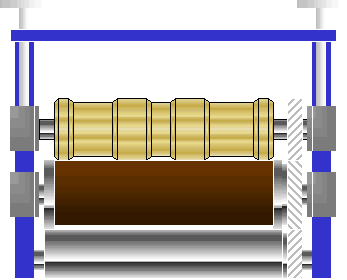 |
The next generation of impression control utilized a cam over center type mechanism where the die remained stationary and the impression roll rotates up to meet it. This system uses air pressure to make and break the impression but will hold its impression regardless of available air pressure. While this approach was a great improvement it is still limited to webs 10" and less. The problem with going to wider webs is that as solid as the base roll may be, by applying pressure to the bearing blocks rather than die bearers allows to much flexing in the die shaft assembly to achieve good speeds on wider webs. |
| The key to achieving high speeds on wider webs is in making the hot stamping system follow the same principles of operation as a cutting die. It has been a long time since applying pressure to the bearing blocks in a die cutting operation was an accepted practice. The latest designs have addressed this issue by adding steel bearers to the hot stamp die. With this design the die and anvil are sandwiched between the lower anvil roll and an assist roll where pressure can be set and monitored. With the die locked tightly in the station the anvil is adjusted independently to meet the die. |
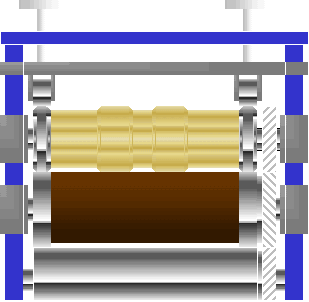 |
TYPES OF HOT STAMPING MATERIALS
Foil Type |
Use |
Comments |
Metallic
|
Prime Labels, health and beauty, wine and spirits, new product promotions, seasonal
|
Continues to grow in popularity among more and more markets
|
Pigment |
White on clear for overprint, signature panels, repair of mis-printed labels |
Higher opacity than any other printing process |
Diffraction |
Tamper proof seals (CD's / video games), low level brand security, transit passes |
Low level security feature that is easy to incorporate, real loud look |
Holographic |
Brand security, especially attractive to high tech industries |
New equipment can apply registered holograms in-line |
Magnetic |
Parking tickets, ATB passes, phone cards |
Growing market segment, superior readability to slurries |
Printed |
Wood grains, marbles, brushed metal |
Used primarily in plastics decorating |
|
|
|
|


